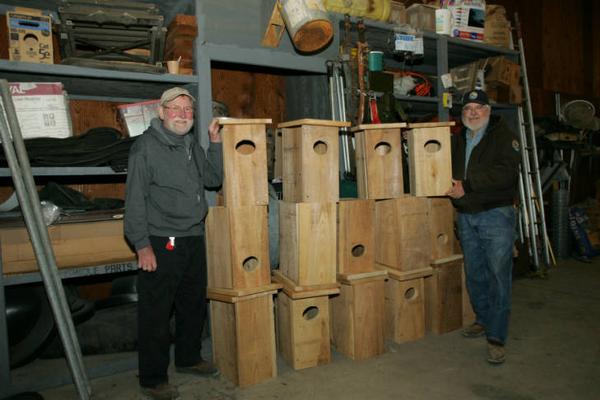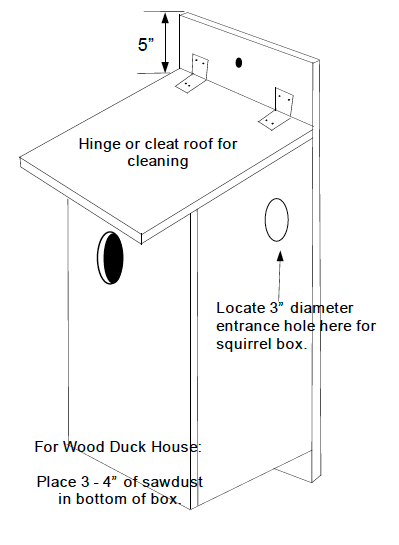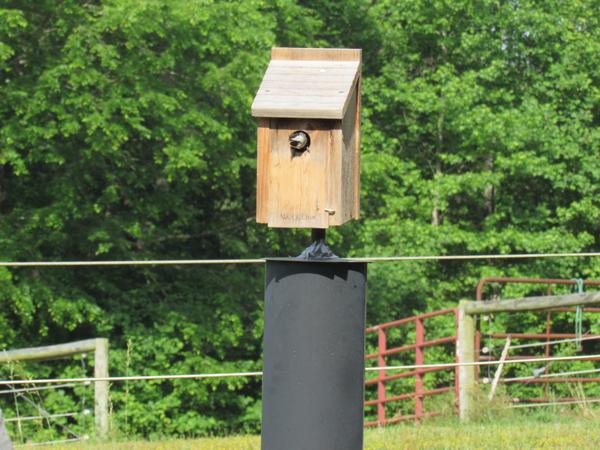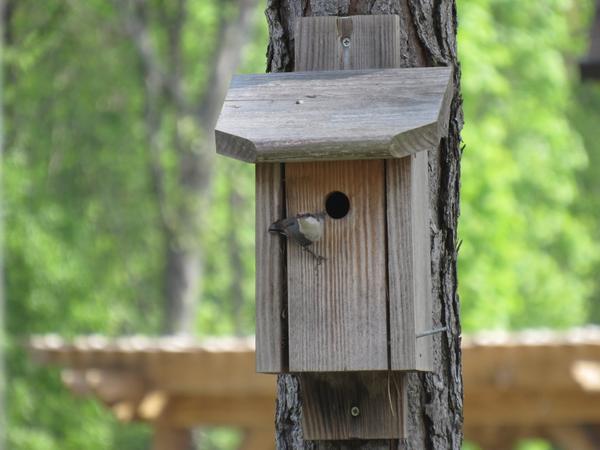Cavity Nesters Need Homes
In a perfect world there would be plenty of dead trees (aka, snags) loaded with cavities in forests for all the wildlife species that require them. However, urban and suburban landscapes, young pine plantations, and many other forest stands often lack adequate snags and associated cavities.
There are two ways to remedy this situation:
- Provide artificial nest boxes (Figure 1)
- Increase the number of natural cavities
This publication will focus on constructing and placing artificial nest boxes. Please consult, Snags and Downed Logs, for details on increasing the number of natural cavities on your forest land. Please consult, Building Songbird Boxes, for details specifically related to songbird nest boxes.
It is critical that nest boxes be constructed and placed in a manner appropriate for the target wildlife species. This publication provides a brief overview of the information that can help you initiate efforts to increase cavity availability for focal cavity users on your property.
Woodland Cavity Nesters
|
Barn owl |
Northern flicker |
|
Pileated woodpecker |
Red-bellied woodpecker |
|
Red-headed woodpecker |
Downy woodpecker |
|
Gray squirrel |
Southern flying squirrel |
|
Wood duck |
Raccoon |
Use nest boxes when:
- Few natural cavities exist
- Competition for natural cavities is great
- Target species populations are low
- Rapid habitat improvement is desired
|
Species |
Hole Diameter (inches) |
Cavity Depth (inches) |
Floor Size (inches) |
Entrance Hole Height (inches) |
Mounting Height (feet) |
|
Southern flying squirrel |
1 ½ |
12 |
7 x 7 |
10 |
10 - 26 |
|
Gray squirrel |
3 |
18 |
8 x 8 |
14 |
18 – 30 |
|
Wood duck |
3 ½ x 4 ½ oval |
23 ½ |
7 ¾ x 9 ¼ |
14 |
20 – 25 |
|
Northern flicker |
2 ½ |
24 |
7 x 7 |
14 x 16 |
6 – 12 |
|
Raccoon |
5 x 9 oval |
24 |
11 ½ x 11 ½ |
19 |
10 – 20 |
|
Barn owl |
3 ¾ x 4 ½ |
16 |
11 x 22 ¾ |
4 |
8-25 |
|
Downy woodpecker |
1 ¼ |
8 - 10 |
4 x 4 |
6 - 8 |
5 - 15 |
|
Red-headed woodpecker |
2 |
12 - 15 |
6 x 6 |
9 - 12 |
10 – 20 |
Tips for Successful Nest Boxes
- Mount nest boxes in areas appropriate for selected species.
- Construct nest boxes using decay and weather resistant materials such as cypress, cedar, heart pine, and oak.
- Avoid using painted or treated wood.
- Place nest boxes in most critical (plantations and young timber stands) areas first, then expand efforts to additional areas as time and money allow.
- Use predator guards whenever possible and practical.
- Fill nest boxes meant for woodpeckers with wood shavings or sawdust, so the adults can complete the excavation process (digging down through the sawdust) that is important for pair bonding.
- Consult wildlife biologists for habitat requirements of species not listed in this publication.
Habitats and Maintenance Tips
|
Species |
Habitat |
|
Gray and flying squirrels |
Young to mature woodlands |
|
Wood duck |
Mature woodlands adjacent to forested wetlands, ponds, or marsh |
|
Northern flicker |
Sparsely wooded areas, field edges |
|
Raccoon |
Forested wetlands, streamside forest |
|
Barn owl |
Areas of extensive grassland, pasture, or agricultural fields |
|
Downy woodpecker |
Suburbs, forest, urban woodlots |
|
Red-headed woodpecker |
Park-like woodlands and golf courses |
Maintenance Tips
- Remove old nesting materials and repair or remount nesting structures annually after young have left the nest.
- Check ventilation and drainage holes for proper functioning during annual cleaning.
- Adjust mounting bolts and wires annually or as needed to account for tree growth or wear and tear.
Working With Wildlife
North Carolina State University Extension - Forestry
Working With Wildlife Series
Publication date: May 24, 2019
Reviewed/Revised: May 28, 2024
N.C. Cooperative Extension prohibits discrimination and harassment regardless of age, color, disability, family and marital status, gender identity, national origin, political beliefs, race, religion, sex (including pregnancy), sexual orientation and veteran status.
N.C. Cooperative Extension prohibits discrimination and harassment regardless of age, color, disability, family and marital status, gender identity, national origin, political beliefs, race, religion, sex (including pregnancy), sexual orientation and veteran status.




